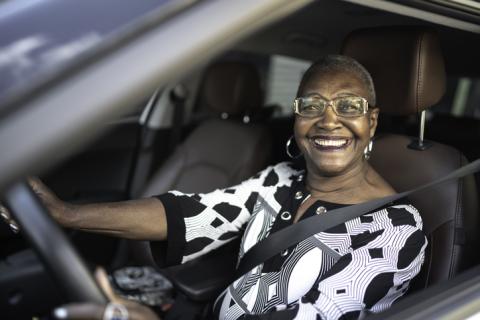“Should I Give Up Driving … Or Get a New Car?”
But in many other cases, a senior’s ability to drive falls into a gray area. Maybe vision is adequate for daytime driving, but not at night. Maybe they have a shoulder problem that makes it hard to look backward. Maybe slower reaction time makes it unsafe to drive in heavy traffic.
Seniors in these situations can adapt, perhaps by choosing to drive only during the daylight hours and avoiding rush hour driving. And if you’re not sure if you or a loved one is safe behind the wheel, ask the doctor for a recommendation for a senior driving specialist.
But sometimes, it’s not the senior who needs to adapt, but their car! According to AAA, when seniors are experiencing driving problems, their car might be a big contributor to the problem. It’s important to keep the car in good repair, of course. Replace worn windshield wipers, add better mirrors, and have the car regularly inspected.
If that’s not enough, it might be that a senior’s car no longer is the best one for their needs. It may be too large. It may not have the best visibility. Although they might feel most comfortable in their old, familiar vehicle, trading it in for a model with high-tech safety features could be a better choice. AAA recommends these features in particular for senior drivers:
- Forward collision warning/mitigation. These systems can help prevent crashes by warning drivers of a potential collision or by automatically applying the brakes. For older drivers, this technology can improve reaction times and reduce crashes by up to 20 percent.
- Automatic crash notification. These systems automatically alert emergency services in the event of a crash. Older drivers are more likely to suffer from the serious effects of a crash, which means these systems can provide a greater safety benefit.
- Parking assist with a rearview display. This technology includes backup cameras and obstacle-detection warning systems, which can help prevent crashes when pulling out of a parking space.
- Parking assist with cross-traffic warning. These systems utilize radar sensor technology to notify drivers of crossing vehicles when backing out of a parking space, and on some vehicles, the systems automatically can apply the brakes to prevent a collision.
- Semi-autonomous parking assistance. These systems take over steering while moving into a parallel parking space, which can reduce stress and make parking easier for older drivers.
- Navigation assistance. Turn-by-turn GPS navigation systems can provide older drivers with an increased feeling of safety, confidence, attentiveness and relaxation, which can help them remain focused on the road and comfortable behind the wheel.
If you are an older driver, or you’re discussing the topic with a senior loved one, know that it’s common to feel pretty intimidated by the cars of today. And there’s a learning curve when it comes to using all those high-tech features.
But making the effort is worth it. Keeping a senior driving longer, and safely, can keep them independent and active in the community. They might be able to continue their paid or volunteer work and stay in their own homes longer. Studies show driving cessation puts older adults at higher risk of depression, inactivity and even financial insecurity. Studies also show that once seniors get the hang of new automotive technologies, they usually gain a lot of confidence and a sense of freedom.
